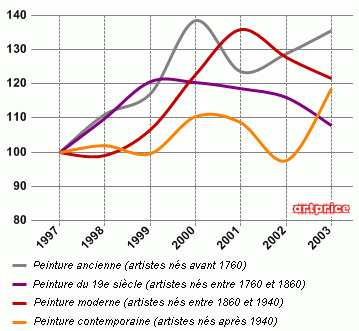What estimates mean to the market
[12 Jan 2004]
The success of an auction depends, of course, on the selection of works for sale, but also on a correct price estimate for each lot. In practice, however, only one out of every five lots sold at auction is knocked down within its estimated range. This suggests that for consignors, auctions usually bring either pleasant surprises or dashed hopes.
The best guarantee against disappointment is an accurate estimate. This is also in the auctioneer’s interest since every unsold lot tarnishes the image of the house and may lose it a client.Over-ambitious vendors risk seeing the works they were hoping to sell bought in. If the demand is not there, lots frequently fail to reach their preset floor prices, a particularly acute danger in times of market uncertainty when buyers tend to be more selective and pick carefully among the pieces on offer. Between January and October 2003, 41% of artworks put up for auction worldwide failed to find a buyer, compared to just 33% in the same period 2000. .

The French market — the world’s biggest by volume, handling almost 17% of fine art lots sold in 2002 — was not spared. In fact, the no sales ratio in France was 43%. Faced with a glut of works to choose from, collectors were happy to ignore the less interesting pieces. In the US, in contrast, where supply has been less plentiful and demand has held up better, the no-sales ratio has hovered around 26% for three years. The UK has also resisted the trend, with a bought-in ratio of close to 33%. These varied performances also reflect the structure of the market. The UK and US dominate in top-of-the-range sales and, in the art market, works estimated at over a million euros tend to find a buyer more easily than those estimated at less than a thousand.
The higher the price, the lower the risk of a no-sale. Between January and October 2003, 32.2% of lots estimated at more than USD 1 million were bought in, compared to 41% of those estimated at less than EUR 10,000. Estimates for pieces likely to sell for a million plus seem, logically enough, to be made with more care and billionaire collectors rarely let exceptional pieces slip by. Only 290 works went under the hammer for more than a million euros last year, which is just one thousandth of all lots sold. Of the works whose low estimate was above EUR 100,000, 25-27% were knocked down within their estimated range. The lower down the price scale you go, the less accurate the estimates: at under EUR 1,000, only 17% of hammer prices are within the estimate range.




 0
0
